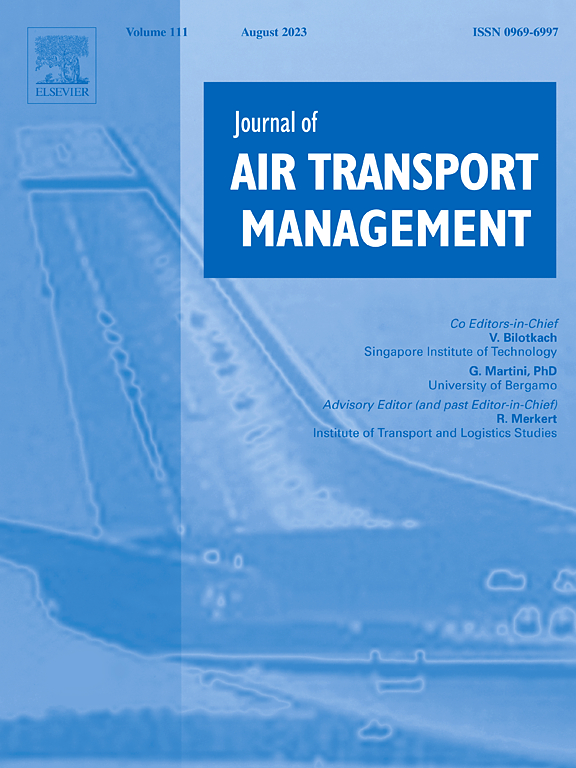Estimating the impacts of traffic intensity, weather conditions, and airspace structure on fuel consumption and flight time of Brazilian commercial aviation
IF 3.6
2区 工程技术
Q2 TRANSPORTATION
引用次数: 0
Abstract
This study employs a statistical modeling approach to commercial aviation fuel consumption and flight time to assess air traffic management (ATM) performance. The study investigates the operational factors that impact ATM efficiency, exploring airport-specific performance. Using datasets from Automatic Dependent Surveillance - Broadcast (ADS-B) surveillance systems, the Brazilian air transport statistical database, and meteorological data, the research develops linear regression models to quantify the effects of traffic intensity, weather conditions, and airspace structure on fuel consumption and flight time. The data covers the Brazilian domestic market from 2018 to 2022, totaling more than 1.3 million flights analyzed. The findings suggest differences in the impacts of traffic intensity and adverse weather conditions among the busiest airports in Brazil. Some airports had better efficiency levels for the same traffic intensity level, while the airspace structure’s impact was somewhat more similar in all major airports. At SBGR, for example, the busiest airport in Brazil, the traffic intensity during arrivals caused about 74 kilograms of extra fuel per flight, while the airspace structure was associated with about 160 kilograms of extra fuel per flight. This research offers insights into quantifying potential savings from ATM improvements by providing a data-driven approach.
估计交通强度、天气条件和空域结构对巴西商业航空燃油消耗和飞行时间的影响
本研究采用商用航空燃油消耗和飞行时间的统计建模方法来评估空中交通管理(ATM)的绩效。该研究调查了影响ATM效率的操作因素,探讨了机场的特定性能。利用自动相关监视-广播(ADS-B)监视系统的数据集、巴西航空运输统计数据库和气象数据,该研究开发了线性回归模型,以量化交通强度、天气条件和空域结构对燃料消耗和飞行时间的影响。该数据涵盖了2018年至2022年的巴西国内市场,共分析了130多万个航班。研究结果表明,在巴西最繁忙的机场中,交通强度和恶劣天气条件的影响存在差异。在相同的交通强度水平下,一些机场的效率水平更高,而各主要机场的空域结构影响程度较为相似。例如,在巴西最繁忙的机场SBGR,到达期间的交通强度造成每架航班约74公斤的额外燃料,而空域结构与每架航班约160公斤的额外燃料有关。这项研究通过提供一种数据驱动的方法,为量化ATM改进的潜在节省提供了见解。
本文章由计算机程序翻译,如有差异,请以英文原文为准。
求助全文
约1分钟内获得全文
求助全文
来源期刊

Journal of Air Transport Management
TRANSPORTATION-
CiteScore
12.40
自引率
11.70%
发文量
97
期刊介绍:
The Journal of Air Transport Management (JATM) sets out to address, through high quality research articles and authoritative commentary, the major economic, management and policy issues facing the air transport industry today. It offers practitioners and academics an international and dynamic forum for analysis and discussion of these issues, linking research and practice and stimulating interaction between the two. The refereed papers in the journal cover all the major sectors of the industry (airlines, airports, air traffic management) as well as related areas such as tourism management and logistics. Papers are blind reviewed, normally by two referees, chosen for their specialist knowledge. The journal provides independent, original and rigorous analysis in the areas of: • Policy, regulation and law • Strategy • Operations • Marketing • Economics and finance • Sustainability
 求助内容:
求助内容: 应助结果提醒方式:
应助结果提醒方式:


